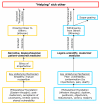Walking a mile in their patients' shoes: empathy and othering in medical students' education
- PMID: 18336719
- PMCID: PMC2278157
- DOI: 10.1186/1747-5341-3-10
Walking a mile in their patients' shoes: empathy and othering in medical students' education
Abstract
One of the major tasks of medical educators is to help maintain and increase trainee empathy for patients. Yet research suggests that during the course of medical training, empathy in medical students and residents decreases. Various exercises and more comprehensive paradigms have been introduced to promote empathy and other humanistic values, but with inadequate success. This paper argues that the potential for medical education to promote empathy is not easy for two reasons: a) Medical students and residents have complex and mostly unresolved emotional responses to the universal human vulnerability to illness, disability, decay, and ultimately death that they must confront in the process of rendering patient care b) Modernist assumptions about the capacity to protect, control, and restore run deep in institutional cultures of mainstream biomedicine and can create barriers to empathic relationships. In the absence of appropriate discourses about how to emotionally manage distressing aspects of the human condition, it is likely that trainees will resort to coping mechanisms that result in distance and detachment. This paper suggests the need for an epistemological paradigm that helps trainees develop a tolerance for imperfection in self and others; and acceptance of shared emotional vulnerability and suffering while simultaneously honoring the existence of difference. Reducing the sense of anxiety and threat that are now reinforced by the dominant medical discourse in the presence of illness will enable trainees to learn to emotionally contain the suffering of their patients and themselves, thus providing a psychologically sound foundation for the development of true empathy.
Figures
References
-
- Monroe KR. The heart of altruism: perceptions of a common humanity. Princeton, NJ: Princeton University Press; 1996.
-
- Darley J, Batson CD. From Jerusalem to Jericho: a study of situational and dispositional variables in helping behaviour. J Pers Soc Psychol. 1973;27:100–108. doi: 10.1037/h0034449. - DOI
-
- Batson CD. The altruism question: Towards a social social-psychological answer. Hillsdale, NJ: Erlbaum; 1991.
-
- Aronson E, Wilson TD, Akert AM. Social psychology. 5. Upper Saddle River, NJ: Prentice Hall; 2005.
-
- Landau RL. "And the least of these is empathy.". In: Spiro H, McCrea-Curnen MG, Peschel E, St. James D, editor. Empathy and the practice of medicine: beyond pills and the scalpel. New Haven: Yale University Press; 1993. pp. 103–109.


